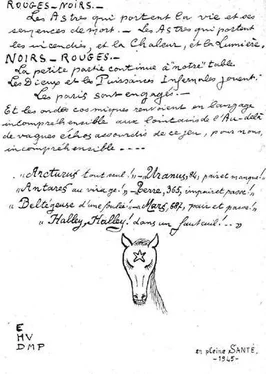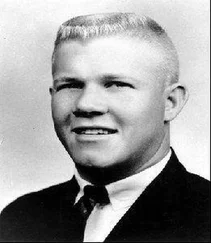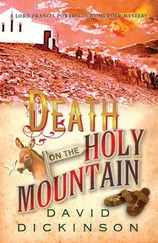When Commissaire Massu requested the file on the Debauve murder from the investigators of the Brigade Mobile of Dijon, it was not found, and detectives began to grow suspicious. Speculations rose about the missing documents, and many people believed that the mayor had used his power to destroy them. Years later, the dossier was actually located—filed not under D for Debauve, but M for murder. Curiously, too, it was slim, containing no record of any interviews or even a reference to Petiot’s arrival on the scene.
Of course, a crime of this nature had attracted a great deal of attention from police, press, and townsmen. One freelance reporter for the local paper, Le Petit Régional , was particularly well informed. His reporting was soon filling in details that perplexed even the main investigators. Among other scoops, he retrieved the hammer used in the murder, from a stream close to the farmhouse, dropped there likely so that the rust would remove any trace of fingerprints. The journalist never signed his name to any of the articles. His identity was only revealed in 1945. It was Marcel Petiot.
Frascot, in the meantime, had been claiming that he knew something about the case that no one else did, insinuating that he had seen Petiot at the dairy before the fire and implying that the hunt for the murderer should begin in the mayor’s office.
What exactly Frascot knew about that night may never be revealed because, a few weeks after Debauve’s death, he agreed to meet with Petiot for a drink at the bar of the Hôtel du Dauphin. During the course of the conversation, Frascot told his doctor that he was suffering from a painful bout of rheumatism. Petiot informed him of a pioneering new drug from Paris that would likely relieve the symptoms, if not also cure him. As a favor to his old friend, Petiot offered to administer the injection for free. They walked to Petiot’s office down the street. Three hours later, one of the most promising witnesses in the murder investigation was dead.
The official cause of Frascot’s death was an aneurysm, or “by accident … from a heart shock, or some unknown side effect resulting from a hypodermic injection.” This is of course possible, but the person who conducted the postmortem and signed the death certification was Villeneuve-sur-Yonne’s medical coroner. And that position—Massu learned with disbelief—was held by Dr. Marcel Petiot.
AFTER finishing a funeral at Passy cemetery, the gravediggers returned to their sieves at the Petiot town house, retrieving the bones and rotten limbs from the pit, placing them in wooden boxes that resembled coffins, and then transporting them to the Institut médico-légal on the place de Mazas in the 12th arrondissement.
The Institut médico-légal (IML) boasted one of the most celebrated forensic laboratories in the world. After moving to this location in 1914, from its previous site just behind Notre Dame, the IML had expanded from its original role as a morgue to being an advanced institution that pioneered the use of science in criminal investigation. One of the groundbreaking investigators was Alphonse Bertillon, an early proponent of what he called “anthropometric” techniques: that is, learning how specific measurements uniquely identify individuals.
As nineteenth-century French law differentiated between first-time and repeat offenders, allowing for more lenient penalties for the former, criminals regularly adopted false aliases to pose as first-timers. Bertillon’s method consisted of measuring every criminal upon arrest on eleven points: height, width of outstretched arms, length and breadth of head, as well as length of the foot, the middle finger, the little finger, the arm from elbow to middle finger, and so on—the left side being preferred in the measurements because it was the least likely to change if the suspect engaged in hard physical labor. Together, these precise measurements would uniquely identify a person. Two people, Bertillon reasoned, may share one, two, or perhaps three of the same measurements, but not all eleven. The odds, he calculated, were 268,435,456 to 1. And then, to address this possibility, he added three additional descriptive points of reference: the color of the suspect’s eyes, hair, and skin.
In February 1883, after years of cataloguing and refining his classification system, Bertillon successfully identified a repeat offender, an achievement that has been heralded as the first use in history of scientific detection to identify a criminal. Over the next few years, Bertillon would repeatedly demonstrate the value of this method, identifying no fewer than 241 offenders in 1884, 425 in 1885, and by the end of the decade, some 3,500. By the mid-1890s, the French police had five million measurements on file.
Bertillon would pioneer a number of other changes as well, from standardizing the photograph of the criminal upon arrest into a front and side “mug shot,” to bringing a camera to document the scene of the crime. He would eventually support the use of fingerprints, though he had first resisted this tool as a challenge to his own identification system. Bertillon’s esteem had risen quickly. Sir Arthur Conan Doyle would make Sherlock Holmes show “enthusiastic admiration of the French savant,” and then, in The Hound of the Baskervilles , Dr. Mortimer credits Holmes and Bertillon as being the two best detectives in Europe.
The current head of the IML was Paris’s chief medical examiner, Dr. Albert Paul, a renowned sixty-five-year-old forensic scientist who came from a family of doctors and lawyers. After studying under Paul Brouardel, a leading expert on forensic pathology and forensic entomology, Paul had become professor of forensic medicine at the Sorbonne in 1918 and worked on many high-profile cases, most famously the Henri Landru case in 1920–1921. Landru had eluded authorities for years as he killed wealthy women, robbed them, and then burned their bodies.
Dr. Paul had cracked the case when, replicating Landru’s technique of disposing of his victims, he burned human body parts in a kitchen stove. “A right foot,” Paul learned, “disappears in fifty minutes, a half skull with brains taken out in thirty-six minutes, the whole skull in one hour ten minutes. A human head with the brain, hair, tongue, etc. disappears in about one hour forty minutes.” The most difficult to dispose of were the trunk and thorax, possibly explaining why the murderer at rue Le Sueur chopped the bodies up before feeding them to the fire.
A legend in his field, Dr. Paul was also no small sensation in Parisian society, where he was known for a wealth of tales, often spiced up with his macabre sense of humor. Commissaire Massu had a great respect for Dr. Paul, whom he called “the doctor of a 100,000 autopsies.” Massu and Paul had met thirty-two years before, in the spring of 1912, when both were starting their careers, Massu at the brigade and Paul at the old coroner’s office on quai de l’Archevêché, before he moved to the Institut after the First World War. Massu had learned among other things that the coroner was a touchy eccentric who hated long questions and could not stand “chatterboxes.” Massu always kept this in mind in his dealings with the temperamental expert.
On the rue Le Sueur case Paul would be assisted by a talented forensic team that included Professors Léon Dérobert and René Piédelièvre of the Museum of Natural History. Both Dérobert and Piédelièvre were specialists in the area of reconstructing fossil remains—an expertise that would prove invaluable in the Petiot investigation. Paul already suspected that work on this case would be more difficult than even Landru.
The coroner’s office was being asked to identify human beings from a horrid mass of decomposed and mutilated remains retrieved from the lime pit, the stove, and the basement of rue Le Sueur. They would have to match arms, legs, torsos, and thighs—much as they might do for a dinosaur skeleton at the museum. They were asked to determine, among other things, the number of victims, identifying them by age and gender as well as cause and time of death. Their report would be crucial evidence to authorities struggling for fundamental facts.
Читать дальше












